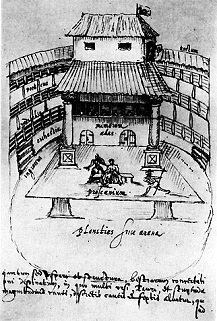London’s Lost Playing Spaces: Walking Tour
Fri 26 October 2012, 5pm-6.30pm
The tour is free, although we ask people to pay a deposit of £3 per ticket via Eventbrite. This will be refunded after the walk for those who attend, no-shows will not be refunded.
Fix Coffee, 126 Curtain Road, London EC2A 3PJ
Think of Whitechapel and whatever you think off you probably don’t think of the theatre. But in 1567, Whitechapel was the location of London’s first purpose-built theatre, the Red Lion. Ten years later, around the corner in Shoreditch a new theatre, The Theatre, had opened and the area continued to thrive as a centre for theatrical activity.
On this walking tour we’ll visit the sites of some of Elizabethan and Jacobean London’s most important theatres in east London: the recently rediscovered Curtain, where Henry V was first performed; The Fortune, for which the original dimensions still survive; and The Red Bull, notorious for attracting rowdy and occasionally criminally violent audiences. Today, with its clubs and pubs, galleries and shops, east London remains a centre for entertainment and this walking tour will seek out its origins as a place of play.
Tamara Atkin, Walk Guide
Tamara is a lecturer in late medieval and early renaissance English literature at Queen Mary, University of London. She was educated at Trinity College, Dublin and University College, Oxford, and she works mainly on medieval and early modern English drama. Her interests lie in a number of related areas: drama and religion in the fifteenth and sixteenth centuries; histories of the book and reading in the medieval and early modern periods; and the periodization of medieval and early modern literature. She has recently completed a book, The Drama of Reform: Theology and Theatricality, 1461-1553 (Brepols, 2013), which explores the relationship between drama and religious reform before and during the English Reformation. Her next project will reappraise late medieval and early renaissance drama as literature by exploring how playbooks were made, who made and bought them, and how they were read.
Also contributing will be Julian Bowsher, Senior Archeologist from Museum of London Archeology.














